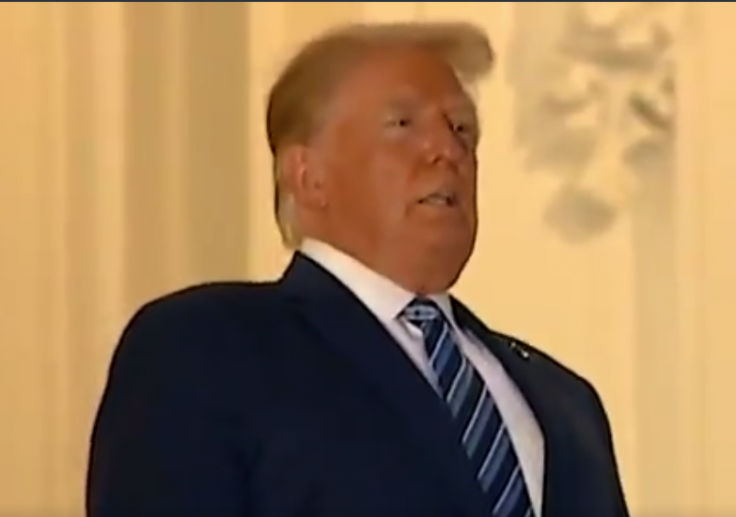President Donald Trump has officially been discharged from Walter Reed Medical Center following his COVID-19 diagnosis and is now back at the White House.
Although the president tweeted that he was feeling "better" than he did two decades ago, video footage of the president appearing to gasp for air and in visible pain before entering the White House is now being circulated on social media.

The president arrived via helicopter on Monday just before 7 p.m. and shortly after climbing the steps leading up to the WH, he paused for a quick photo-op at the top. He then removed his face mask and appeared to be struggling to breathe and wincing in pain, leading many to believe that the president's condition is much worse than he wants people to believe.
Trump appears to be wincing in pain while he breathes pic.twitter.com/YKhGhu0VN0
— Brennan Murphy (@brenonade) October 5, 2020
#GaspingForAir
The video clips have spurred the hashtag #GaspingForAir, which has now become a trending topic on Twitter, with several users claiming Trump is far from fine. "Trump looks like a goldfish that fell out of the fishbowl onto the floor, gasping for breath," wrote one user.
Another user claiming to be a COVID-19 survivor commented: "I remember that gasp for air. I couldn't complete sentences without running gasping for air. Trump's lung function will crash in 3 days. Trump is a #COVIDIOT who's risking his life by leaving the hospital to return to the White House."
"As someone who knows what it looks like when my Mom needs her oxygen, and or a breathing treatment, since age 5. The gasping for a breath, not being able to get air to your lungs, the struggle for air," opined a third user. "This liar is not OK, and he is sure as hell is not immune!"
Doctor's Opinion
Dr. Jane Doe, who goes by the Twitter handle @Caerage, tweeted that the rising of the president's chest wall, his usage of extra respiratory muscles to breathe and open mouth breathing, taking in shallow breaths more than twice the normal amount are all signs that the president's is suffering from "respiratory distress."
I watched the video of Trump on the balcony.
— JaneDoeMD (@Caerage) October 6, 2020
Here is what I saw:
-Extra-respiratory muscles to breathe.
-Visible chest wall rise.
-Open mouth breathing at times.
-Rapid shallow breaths at roughly 25-30 breaths per minute. More than twice normal.
This is respiratory distress.
Dr. Emily Porter also echoed Dr. Doe's sentiments, stating that what Trump is doing is called "retracting," in which he can be seen recruiting his muscles to help him catch a breath.
Babies do this when they have RSV and other respiratory illness. It's called "retracting" and this video demonstrates it well. Trump is recruiting his sternoleidomastoid and "strap muscles" to help him catch big breath. It is much more noticeable with the mask off. https://t.co/uwYWzeK8XW
— Dr. Emily Porter, M.D. (@dremilyportermd) October 6, 2020
Here's what some of the other doctors have to say:
Experts say Trump is clearly using extra accessory neck muscles to draw in air to breath. #COVID19 #TrumpCovid pic.twitter.com/V29EAhI8G5
— Eric Feigl-Ding (@DrEricDing) October 6, 2020
Retired RN here.The heaving of Trump's chest, lifting of his head, opening of his mouth, etc are called "accessory muscle use," sure signs of difficulty breathing. #GaspingForAir https://t.co/OFUc63o9T6
— IhoPwaitress74 🌹Hawkins 4 President🌻🦄🔥🕊ï¸ðŸŒ·âš•ï¸ (@IhoPwaitress74) October 6, 2020
Not much is known about President Trump's battle with COVID-19, which he tested positive for last week. As a matter of fact, even the date he contracted it is being disputed, among other details. Conspiracy theories have flooded social media about the seriousness of his condition, which drugs he's taking, whether he's fit to perform as chief of state, and if steroids are to blame for his all-caps tweet-storm.
So when he prematurely left Walter Reed, where he was receiving treatment for his coronavirus infection since Friday, to return to the White House, his attempts to look healthy and fine didn't seem to convince everyone.








